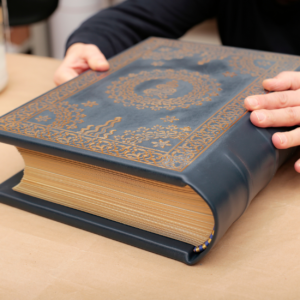BIBLIOTHÈQUE NATIONAL DE FRANCE (MS Italiano 2017)
BIBLIOTECA DI IMOLA (MS 76)
“The love that moves the sun and the other stars.”
The Divine Comedy is considered one of the greatest masterpieces of world literature.
This manuscript is unique. The original, from which the facsimile was derived, is divided between two libraries in two cities, from which it takes its name, belonging to two different national states.
The only way to consult and admire the codex as it was originally created is to purchase the three-dimensional reproduction, which has reunited what historical and political events have divided.
The Inferno (ms. 76) is one of the most richly decorated medieval copies of Dante’s masterpiece, executed for the Duke of Milan Filippo Maria Visconti. It is among the most beautiful works of the “Master of the Vitae Imperatorum,” a highly prestigious illuminator in northern Italy during the first half of the 15th century.
This codex is unique for the quantity and quality of the miniatures, with three or four admirable ones per canto. In most cases, few scenes are inserted in the initials of each cantica. It is not excluded that Guiniforte Barzizza himself may have played a role in the preparation of the demanding illustrative program: the Paris-Imola codex was originally adorned with over 115 scenes, of which 72 remain today.
The codex is currently divided between the Bibliothèque Nationale de France, which preserves the majority, with 59 images (ms. Italien 2017), and the Biblioteca di Imola which preserves 21 folios with 13 miniatures.
$6 999.00
50 in stock
Dante narrates an imaginary journey through the Afterlife, which begins on Good Friday of 1300. Lost in a “dark forest,” symbol of spiritual loss, he is saved by Virgil, who guides him through Hell and Purgatory. Then he is accompanied by Beatrice, symbol of divine Grace, through Paradise.
The journey represents the soul’s path towards salvation and eternal bliss.
INFERNO
Dante traverses the 9 circles of Hell, where the damned suffer eternal punishments according to the sins committed in life (lust, betrayal, violence, fraud…). In the center of Hell is Lucifer, immersed in ice.
Dante and Virgil exit “to see the stars again.”
The collecting history of the codex is extraordinary. It was originally kept at the famous Visconti-Sforza library in Pavia, which still held it in 1469.
With the French descent into Italy at the end of the century, it passed into the hands of King Louis XII.
The French sovereign probably offered it shortly after to Giovanni Caracciolo, Duke of Melfi, as a reward for services rendered to the crown.
The work then passed to Caracciolo’s son-in-law Antoine de Cardaillac and subsequently to his heirs.
In 1835, after nearly four hundred years, it was recovered in a castle in the Dordogne by the scholar Gaston de Flotte, who purchased it and brought it to Marseille.
Between 1836 and 1837, he made arrangements with the exiled Giuseppe Zaccheroni from Imola, who played an important role in the revolutionary movements preceding Italian unification, to publish its still unpublished text. Zaccheroni, exiled in France after the 1831 uprisings, produced the critical edition of the text contained in the codex, which he published in 1838. After returning to Italy, he was elected deputy in 1865 in the Imola constituency. In 1866, Zaccheroni donated to his city’s library a copy of the Inferno edition he had curated, which he enriched by inserting handwritten pages from the codex in his possession between the printed pages. The remaining part of the Visconti codex was sold in 1887 by de Flotte’s heirs to the Bibliothèque Nationale de France, where it is still preserved.
The Divine Comedy, one of humanity’s great masterpieces, lends itself to various levels of interpretation, from the most immediate to the most secret and esoteric. This could be a consequence of Dante’s alleged membership, along with his mentor Cavalcanti, in a secret society heir to the Templar Order, the Fedeli d’Amore. Beatrice is not just the beloved person but Wisdom, the True Light.

Note: Each work is created exclusively after purchase. During production, we are committed to updating the customer with photos and videos of the preparation stages of the purchased work.
This allows us to make your experience and the work you decide to purchase exclusive. For this reason, from the moment of purchase, the production time will be 14 working days. Subsequently, we will proceed to send the product via insured courier.